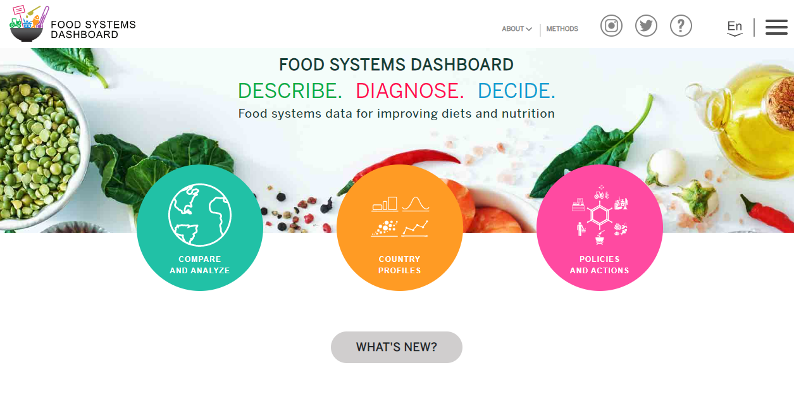The Challenge
Food systems are critical determinants of human and planetary health. Despite their importance, the indicators that describe the external drivers, components, and outcomes of food systems were previously fragmented across many different sources, with some inaccessible behind paywalls, presenting a challenge for stakeholders to access and understand food systems data and make evidence-based decisions. The need for this data to be easily accessible and understandable is amplified by the inherent complexity and interconnectedness of food systems.
Overview
The Food Systems Dashboard is an innovative platform that aims to empower users to understand their food systems, assess challenges, set priorities, and decide on actions through the Dashboard’s Describe, Diagnose, and Decide.
Describe focuses on characterizing global, regional, and national food systems by bringing together over 200 indicators from over 40 public and private sources for more than 190 countries and territories. It is the first dashboard to bring together indicators across food systems including food supply chains, food environments, individual factors, consumer behavior, diets and nutrition, and environment as well as external drivers. These indicators are available to visualize on the Dashboard as maps, a variety of graphs and charts, and tables or to download as a dataset and use independently. Users can also view Country Profiles that show curated data visualizations for around 40 key indicators, providing snapshots of countries’ food systems. New indicators are continually being evaluated and added to the Dashboard and the data for existing indicators is updated as available. Future work includes creating country dashboards with subnational data.
Diagnose and Decide focus on identifying challenges in food systems at the national level and offering decision options to address these issues. The diagnostic approach sets thresholds for a curated selection of around 40 indicators and classifies each as in the red (likely challenge area), yellow (possible challenge area), or green for each country. Each diagnostic indicator is paired with actions that could be taken in response, which come from the 42 Policies and Actions and Project Disrupt. Future work includes expanding these decision options and using machine learning to increase the sophistication of the linkages between the diagnosis and recommended actions.
The Dashboard also contains a typology developed to classify national food systems into one of five types: rural and traditional, informal, and expanding, emerging and diversifying, modernizing, and formalizing, and industrialized and consolidated. This typology highlights common patterns in food supply chains and food environments that exist across countries. By comparing these different food systems types, users can understand the complexity of food systems and begin to identify priority areas of action within their own food systems.
The goals of the Dashboard are:
- To improve stakeholders’ awareness of the different core components of national food systems — food supply chains, food environments, individual factors, and consumer behavior — and how these components influence diets, nutrition, and health, livelihood, and environmental outcomes;
- To enable stakeholders to compare their food systems with those of other countries of a similar food systems type; and
- To diagnose challenge areas and suggest priority areas of action — in the form of policy and program interventions, tools, and investments — for improving food systems’ contribution to human and planetary health.
Project Team

The Dashboard was developed by an international, multi-disciplinary team of over 30 people across nine core organizations and six partner organizations led by Johns Hopkins University and the Global Alliance for Improved Nutrition. Collaborators include the Food and Agriculture Organization of the United Nations, the Alliance of Bioversity International and CIAT, Harvard University, City, University of London, University of Michigan, Michigan State University, and the Agriculture-Nutrition Community of Practice.
